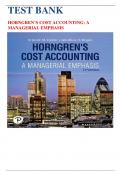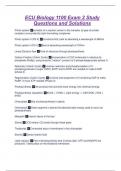TEST BANK
HORNGREN’S COST ACCOUNTING: A
MANAGERIAL EMPHASIS
, Table of contents
1. The Manager and Management Accounting
2. An Introduction to Cost Terms and Purposes
3. Cost–Volume–Profit Analysis
4. Job Costing
5. Activity-Based Costing and Activity-Based Management
6. Master Budget and Responsibility Accounting
7. Flexible Budgets, Direct-Cost Variances, and Management Control
8. Flexible Budgets, Overhead Cost Variances, and Management Control
9. Inventory Costing and Capacity Analysis
10. Determining How Costs Behave
11. Data Analytic Thinking and Prediction
12. Decision Making and Relevant Information
13. Strategy, Balanced Scorecard, and Strategic Profitability Analysis
14. Pricing Decisions and Cost Management
15. Cost Allocation, Customer-Profitability Analysis, and Sales-Variance Analysis
16. Allocation of Support-Department Costs, Common Costs, and Revenues
17. Cost Allocation: Joint Products and Byproducts
18. Process Costing
19. Spoilage, Rework, and Scrap
20. Balanced Scorecard: Quality and Time
21. Inventory Management, Just-in-Time, and Simplified Costing Methods
22. Capital Budgeting and Cost Analysis
23. Management Control Systems, Transfer Pricing, and Multinational Considerations
24. Performance Measurement, Compensation, and Multi-national Considerations
S
,Cost Accounting, 17e (Horngren/Datar/Rajan)
Chapter 1 The Accountant's Role In The
Organization
Objective 1.1
1) Management Accounting:
A) Focuses On Estimating Future Revenues, Costs, And Other Measures To Forecast Activities
And Their Results
B) Provides Information About The Company As A Whole
C) Reports Information That Has Occurred In The Past That Is Verifiable And Reliable
D) Provides Information That Is Generally Available Only On A Quarterly Or Annual
Basis
Answer: A
Diff: 2
Terms: Treasury
Objective: 1
AACSB: Reflective Thinking
2) Managers Use Management Accounting Information To Strategy.
A) Choose
B) Communicate
C) Implement
D) All Of These Answers Are
Correct.
Answer: D
Diff: 1
Terms: Total Quality Management (TQM)
Objective: 1
AACSB: Analytical Skills
3) Financial Accounting:
A) Focuses On The Future And Includes Activities Such As Preparing Next Year's Operating Budget
B) Must Comply With GAAP (Generally Accepted Accounting Principles)
C) Reports Include Detailed Information On The Various Operating Segments Of The Business
Such As Product Lines Or Departments
D) Is Prepared For The Use Of Department Heads And Other
Employees
Answer: B
Diff: 2
Terms: Financial Accounting
Objective: 1
AACSB: Reflective Thinking
,4) The Person Most Likely To Use ONLY Financial Accounting Information Is A:
A) Factory Shift Supervisor
B) Vice President Of Operations
C) Current Shareholder
D) Department
Manager
Answer: C
Diff: 1
Terms: Financial Accounting
Objective: 1
AACSB: Analytical Skills
5) Which Of The Following People Is LEAST Likely To Use Management Accounting Information?
A) The Controller
B) A Shareholder Evaluating A Stock Investment
C) The Treasurer
D) An Assembly Department
Supervisor
Answer: B
Diff: 1
Terms: Treasury
Objective: 1
AACSB: Analytical Skills
6) Financial Accounting Provides The Primary Source Of Information For:
A) Decision Making In The Finishing Department
B) Improving Customer Service
C) Preparing The Income Statement For Shareholders
D) Planning Next Year's Operating
Budget
Answer: C
Diff: 2
Terms: Financial Accounting
Objective: 1
AACSB: Reflective Thinking
7) Which Of The Following Descriptors Refers To Management Accounting Information?
A) It Is Verifiable And Reliable.
B) It Is Driven By Rules.
C) It Is Prepared For Shareholders.
D) It Provides Reasonable And Timely
Estimates.
Answer: D
Diff: 2
Terms: Treasury
Objective: 1
AACSB: Reflective Thinking
,8) Which Of The Following Statements Refers To Management Accounting Information?
A) There Are No Regulations Governing The Reports.
B) The Reports Are Generally Delayed And Historical.
C) The Audience Tends To Be Stockholders, Creditors, And Tax Authorities.
D) It Primarily Measures And Records Business
Transactions.
Answer: A
Diff: 2
Terms: Treasury
Objective: 1
AACSB: Reflective Thinking
9) Which Of The Following Groups Would Be LEAST Likely To Receive Detailed Management
Accounting Reports?
A) Stockholders
B) Sales Representatives
C) Production Supervisors
D) Managers
Answer: A
Diff: 1
Terms: Treasury
Objective: 1
AACSB: Analytical Skills
10) Management Accounting Information Includes:
A) Tabulated Results Of Customer Satisfaction Surveys
B) The Cost Of Producing A Product
C) The Percentage Of Units Produced That Are Defective
D) All Of These Answers Are
Correct. Answer: D
Diff: 1
Terms: Treasury
Objective: 1
AACSB: Reflective Thinking
11) Cost Accounting:
A) Provides Information On The Efficiency Of Factory Labor
B) Provides Information On The Cost Of Servicing Commercial Customers
C) Provides Information On The Performance Of An Operating Division
D) All Of These Answers Are
Correct. Answer: D
Diff: 1
Terms: Cost Accounting
Objective: 1
AACSB: Reflective Thinking
,12) Which Of The Following Types Of Information Are Used In Management Accounting?
A) Financial Information
B) Nonfinancial Information
C) Information Focused On The Long Term
D) All Of These Answers Are
Correct. Answer: D
Diff: 2
Terms: Treasury
Objective: 1
AACSB: Reflective Thinking
13) Modern Cost Accounting Plays A Role In:
A) Planning New Products
B) Evaluating Operational Processes
C) Controlling Costs
D) All Of These Answers Are
Correct. Answer: D
Diff: 1
Terms: Cost Accounting
Objective: 1
AACSB: Reflective Thinking
14) A Data Warehouse Or Infobarn:
A) Is Reserved For Exclusive Use By The CFO
B) Is Primarily Used For Financial Reporting Purposes
C) Stores Information Used By Different Managers For Multiple Purposes
D) Gathers Only Nonfinancial
Information Answer: C
Diff: 1
Terms: Cost Accounting
Objective: 1
AACSB: Reflective Thinking
15) Cost Accounting Provides All Of The Following EXCEPT:
A) Information For Management Accounting And Financial Accounting
B) Pricing Information From Marketing Studies
C) Financial Information Regarding The Cost Of Acquiring Resources
D) Nonfinancial Information Regarding The Cost Of Operational
Efficiencies Answer: B
Diff: 2
Terms: Cost Accounting
Objective: 1
AACSB: Reflective Thinking
,16) Management Accounting Includes All Of The Following EXCEPT
A) Implementing Strategies
B) Developing Budgets
C) Preparing Special Studies And Forecasts
D) Preparing The Statement Of Cash
Flows Answer: D
Diff: 1
Terms: Treasury
Objective: 1
AACSB: Reflective Thinking
17) Financial Accounting Is Concerned Primarily With:
A) External Reporting To Investors, Creditors, And Government Authorities
B) Cost Planning And Cost Controls
C) Profitability Analysis
D) Providing Information For Strategic And Tactical
Decisions Answer: A
Diff: 2
Terms: Financial Accounting
Objective: 1
AACSB: Reflective Thinking
18) Financial Accounting Provides A Historical Perspective, Whereas Management
Accounting Emphasizes:
A) The Future
B) Past Transactions
C) A Current Perspective
D) Reports To
Shareholders Answer: A
Diff: 1
Terms: Financial Accounting
Objective: 1
AACSB: Reflective Thinking
19) An Enterprise Resource Planning System Can Best Be Described As:
A) A Collection Of Programs That Use A Variety Of Unconnected Databases
B) A Single Database That Collects Data And Feeds It Into Applications That Support Each Of The
Company's Business Activities, Such As Purchases, Production, Distribution, And Sales
C) A Database That Is Primarily Used By A Purchasing Department To Determine The Correct
Amount Of A Particular Supply Item To Purchase
D) A Sophisticated Means Of Linking Two Or More Companies To Facilitate Their Planning
Processes Answer: B
Diff: 1
Terms: Cost Accounting
Objective: 1
AACSB: Use Of Information Technology
,20) The Approaches And Activities Of Managers In Short-Run And Long-Run Planning And Control
Decisions That Increase Value For Customers And Lower Costs Of Products And Services Are Known
As:
A) Value Chain Management
B) Enterprise Resource Planning
C) Cost Management
D) Customer Value
Management Answer: C
Diff: 1
Terms: Cost
Management Objective:
1
AACSB: Analytical Skills
21) Management Accounting Information Focuses On External
Reporting. Answer: FALSE
Explanation: Management Accounting Information Focuses On Internal Reporting.
Diff: 1
Terms: Treasury
Objective: 1
AACSB: Reflective Thinking
22) Cost Management Is Narrowly Focused On A Continuous Reduction Of
Costs. Answer: FALSE
Explanation: Cost Management Is Broadly Focused To Provide Information That Helps Managers At
All Levels Implement, Monitor, And Evaluate Company Strategies.
Diff: 2
Terms: Cost
Management Objective:
1
AACSB: Analytical Skills
23) Managers Always Require The Information In An Accounting System To Be Presented In The
Same Format.
Answer: FALSE
Explanation: Individual Managers Often Require The Information In An Accounting System To Be
Presented Or Reported Differently.
Diff: 1
Terms: Treasury
Objective: 1
AACSB: Analytical Skills
24) Modern Cost Accounting Takes The Perspective That Collecting Cost Information Is A Function
Of The Management Decisions Being Made.
Answer: TRUE
Diff: 1
Terms: Cost Accounting
Objective: 1
AACSB: Analytical Skills
,25) The Balance Sheet, Income Statement, And Statement Of Cash Flows Are Used For Financial
Accounting, And Also For Management Accounting.
Answer: TRUE
Diff: 1
Terms: Financial Accounting
Objective: 1
AACSB: Analytical Skills
26) Financial Accounting Is Broader In Scope Than Management
Accounting. Answer: FALSE
Explanation: Management Accounting Is Broader In Scope Than Financial
Accounting. Diff: 2
Terms: Financial Accounting, Management Accounting
Objective: 1
AACSB: Reflective Thinking
27) Cost Accounting Measures And Reports Short-Term, Long-Term, Financial, And Non
Financial Information.
Answer: TRUE
Diff: 2
Terms: Cost Accounting
Objective: 1
AACSB: Reflective Thinking
28) Cost Management Provides Information That Helps Increase Value For
Customers. Answer: TRUE
Diff: 1
Terms: Cost
Management Objective:
1
AACSB: Reflective Thinking
29) Management Accounting Has To Strictly Follow The Rules Of Generally Accepted Accounting
Principles For The Purposes Of Measurement And Reporting.
Answer: FALSE
Explanation: Internal Measures And Reports Do Not Have To Follow
GAAP. Diff: 1
Terms: Treasury
Objective: 1
AACSB: Ethical Reasoning
30) An Ideal Database Should Store Information In A Way That Allows Different Managers To
Access The Information They Need.
Answer: TRUE
Diff: 1
Terms: Treasury
Objective: 1
AACSB: Reflective Thinking
, 31) An Enterprise Resource Planning (ERP) System Is A Single Database That Collects Data And Feeds
Into Applications That Support Each Of The Company's Business Activities, Such As Purchases,
Production, Distribution, And Sales.
Answer: TRUE
Diff: 1
Terms: Treasury
Objective: 1
AACSB: Use Of Information Technology
32) Cost Accounting Provides Information Only For Management Accounting
Purposes. Answer: FALSE
Explanation: Cost Accounting Provides Information For Financial Accounting As Well As For
Management Accounting Purposes.
Diff: 1
Terms: Cost Accounting
Objective: 1
AACSB: Reflective Thinking
33) Cost Management Involves Long-Term And Short-Term Decisions That Attempt To Increase
Value For Customers And Lower Costs Of Products Or Services.
Answer: TRUE
Diff: 1
Terms: Cost
Management Objective:
1
AACSB: Reflective Thinking
34) For Each Report Listed Below, Identify Whether The Major Purpose Of The Report Is For (1)
Routine Internal Reporting, (2) Nonroutine Internal Reporting, Or For (3) External Reporting To
Investors And Other Outside Parties.
Item:
a. Study Detailing Sale Information Of The Top-Ten Selling Products
b. Weekly Report Of Total Sales Generated By Each Store In The Metropolitan Area
c. Annual Report Sent To Shareholders
d. Monthly Report Comparing Budgeted Sales By Store To Actual
Sales Answer:
a. (2) Nonroutine Internal Reporting
b. (1) Routine Internal Reporting
c. (3) External Reporting To Investors And Other Outside Parties
d. (1) Routine Internal
Reporting Diff: 2
Terms: Treasury
Objective: 1
AACSB: Analytical Skills





